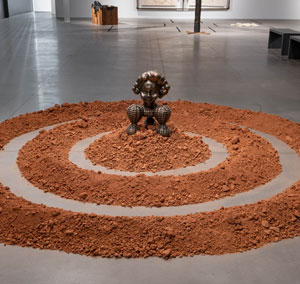1.15.24 — And a Mule
Crown Heights lives in the shadow of present-day gentrification, its former glory, poverty, and art. The Brooklyn Museum stands just blocks away. But who knew that, well before, it was the first free black community in the United States?
An artist remembers, and a video looks to this past Juneteenth, when, in celebration, skywriting traced its borders. Their five hundred acres look still more evocative in prints. One could mistake their white arc against the blue of the sky for abstract painting. Sandy Williams IV calls his installation, more modestly, 40 Acres, and it also includes a display case for the broken promises of Reconstruction—not to mention General Sherman’s promise to freed slaves of forty acres and a mule.  A lot of voices are talking, all at once—part of the cacophony in the 2023 “Open Call” at the Shed, through January 21. For all its pleasures, it could have one longing for the clarity and quiet of open sky.
A lot of voices are talking, all at once—part of the cacophony in the 2023 “Open Call” at the Shed, through January 21. For all its pleasures, it could have one longing for the clarity and quiet of open sky.
An open call should mean other voices, and the clamor of this one is welcome. Amid the ghastly luxury of Hudson Yards, it brings almost exclusively people of color, roughly half of them women. The Shed is finally learning how to use its cavernous spaces for art. It does not always have exhibitions rather than performance, apart from the art fairs, with their endless partitions and limitless display of cash. Here it sets out all but one work in a single wide-open floor, well lit and without boundaries, so that the artists really do speak to one another. Sill, as with Sandy Williams, a more confusing clamor arises from within.
Sometimes it arises from the demands on the artist, in trying to find herself. When Cathy Linh Che looks to Vietnam, she sees her parents after the fall of Saigon. Many refugees ended up in camps, where, improbable as it sounds, Francis Ford Coppola hired them as extras for Apocalypse Now. Che’s video, in conjunction with Christopher Radcliff, has three channels for three sources—her parents, the movie, and a documentary recreation. The sources and channels almost never line up, adding to the din. Still, family voices speak directly to you.
More often, the clamor arises from the demands of history. Minne Atairu places a bronze figurine, after West African art, on a mound of red soil with more red circles around it. The bronze refers to the looting of antiquity by British colonists, the circles to ones that surrounded an entire community, Benin, in present-day Nigeria. Yet Atairu relies on 3D printing, and the work stands poignantly on its own. So much for history. The show has long labels for each artist, and you will need them, but you may also wish that you could throw them away.
With Atairu, the labels deepen the work. That is not always the case. One hardly needs to know more when Bryan Fernandez paints Dominican refugees at home in Massachusetts, with spacious interiors and wide streets. Now if only immigrant life were always so sunny. One hardly wants more when Jake Brush runs on about his obsession with a pet-store owner on TV. A little goes a long way.
At times the demands feel more like a homework assignment than art. Lizania Cruz supplies a weighty one at that, about American plans to invade Spanish territory in the Caribbean, with Frederick Douglass the commission’s assistant secretary. A chandelier topped with orchids hangs close to the floor for Jeffrey Meris. Now if only I believed that its flowers stood for bullets and its lights for fireworks after the killing of George Floyd. An open wood frame with suggestive additions could pass for a dome by Buckminster Fuller shorn of its top. I shall just have to accept that Armando Guadalupe Cortés replicates an arena for cockfighting and masculinity in Mexico.
As so often, some of the best art leaves one uncertain how to take it, with or without words. I may never know for sure how a box of black leather, a wall of white fabric, and an empty coat rack for Calli Roche relate to death, ecdysis (or a casting off), and “the birth of the self.” I shall, though, remember a figure emerging from or sinking into the blackness. I could never have known that Luis A. Gutierrez reproduces a worker’s strike and a corporate massacre at United Fruit nearly one hundred years ago. After all, the screenprints bathed in paint attest to forgetting. And yet the three rows of unstretched canvas will catch anyone’s eye from anywhere in the room.
Read more, now in a feature-length article on this site.